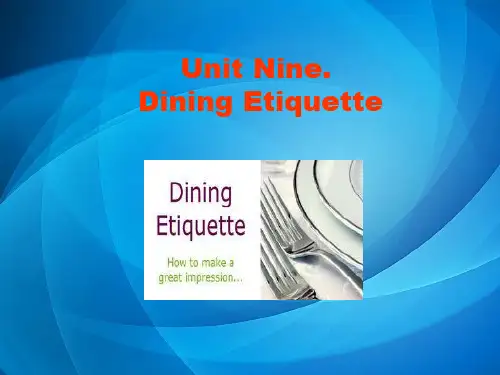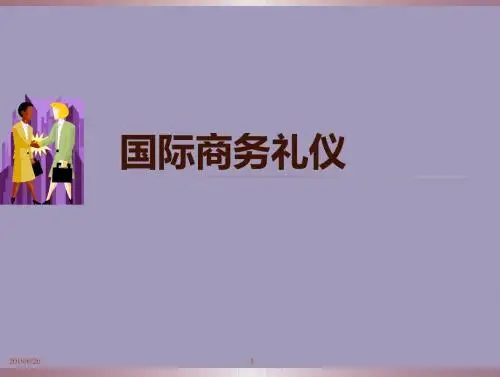国际商务礼仪pdf
- 格式:doc
- 大小:45.04 KB
- 文档页数:25

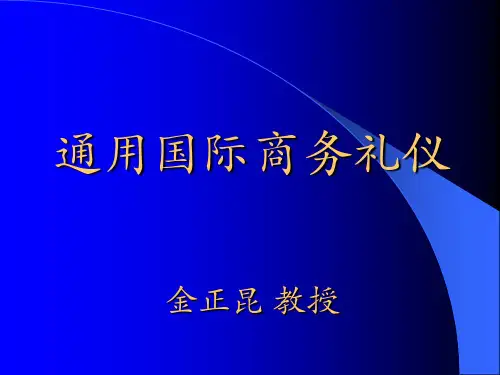

商务礼仪扫描版.pdf商务礼仪扫描版.pdf篇一:商务礼仪教材目录序言 (1)第一章商务礼仪的基础知识 (2)一、礼仪的概念 (2)二、商务礼仪的概念 (2)三、商务礼仪与传统礼仪的共通性及区别性…………………………….….………..2四、五、六、七、第二章一、二、三、四、五、第三章一、二、三、四、五、六、七、八、第四章一、二、商务礼仪的基本特征.........................................................................2商务礼仪的重要性. (3) 商务礼仪的六大准则.........................................................................3商务礼仪形成的六大原则. (3)商务礼仪知识培训----仪容 (4)商务仪容的三点基本要求....................................................................4商务职员的仪容标准..........................................................................4商务女性的美容化妆礼仪....................................................................4商业男性的美容礼仪.. (5) 仪容中的细节 (5)商务礼仪知识培训----着装.............................................................6商务人员职场着装的类型...................................................................6商务人员的着装的规范......................................................................6商务人员着装的TPo原则. (6)商务场合的不同类型………………………………………………………….……6商务活动中穿着西装的注意事项………………………………………….………7国际三大主流西装款式……………………………………….……………………7领带的结法及注意事项…………………………………………………………….8商务女士配戴首钸注意事项................................................................9商务礼仪知识培训----体态.............................................................10什么叫体态语言..............................................................................10体态语言的五种功能(10)三、正确解读体态语言 (10)四、常见体态语言的一般含义 (10)五、商务人员的站姿训练 (11)六、商务人员的坐姿训练 (11)七、商务人员的蹲姿的基本要求 (12)八、商务人员的走姿训练 (13)九、商务人员的手势礼仪 (13)十、商务人员鞠躬的基本规范 (14)第五章商务礼仪知识培训----交谈、表情 (15)一、商务交谈的注意事项 (15)二、商务交谈的忌语 (15)三、商务交谈的三不准 (15)四、表情在商务中的作用 (16)五、商务人员的目光训练 (16)六、嘴部所表达的含义 (16)七、商务人员微笑礼仪训练 (16)第六章商务接待礼仪 (18)一、二、三、四、五、办公室接待礼仪............................................................................18商务活动中的介绍礼仪...................................................................18商务活动中的电话礼仪...................................................................19递名片的商务礼仪.........................................................................19商务宴的基本礼仪. (19) 序言礼仪是一门较强的行为科学,现代社会对礼仪的要求越来越广泛,礼仪的规范化也越来越受到人们的重视,各行各业的从业人员对礼仪知识的需求也越来越迫切。

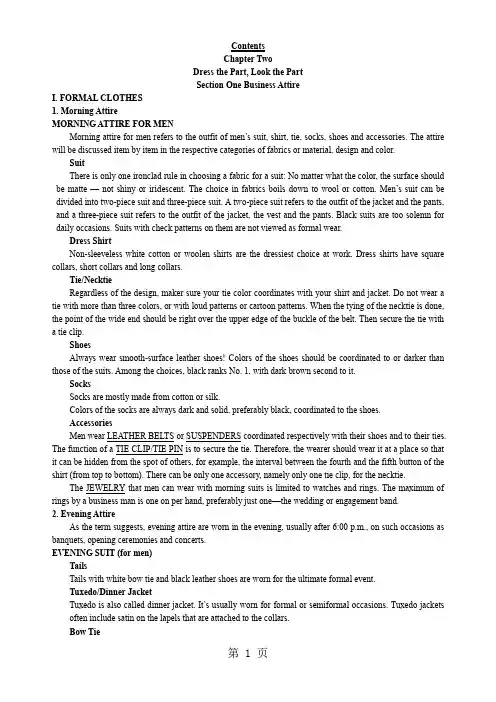
ContentsChapter TwoDress the Part, Look the PartSection One Business AttireI. FORMAL CLOTHES1. Morning AttireMORNING ATTIRE FOR MENMorning attire for men refers to the outfit of men’s suit, shirt, tie, socks, shoes and accessories. The attire will be discussed item by item in the respective categories of fabrics or material, design and color.SuitThere is only one ironclad rule in choosing a fabric for a suit: No matter what the color, the surface should be matte — not shiny or iridescent. The c hoice in fabrics boils down to wool or cotton. Men’s suit can be divided into two-piece suit and three-piece suit. A two-piece suit refers to the outfit of the jacket and the pants, and a three-piece suit refers to the outfit of the jacket, the vest and the pants. Black suits are too solemn for daily occasions. Suits with check patterns on them are not viewed as formal wear.Dress ShirtNon-sleeveless white cotton or woolen shirts are the dressiest choice at work. Dress shirts have square collars, short collars and long collars.Tie/NecktieRegardless of the design, maker sure your tie color coordinates with your shirt and jacket. Do not wear a tie with more than three colors, or with loud patterns or cartoon patterns. When the tying of the necktie is done, the point of the wide end should be right over the upper edge of the buckle of the belt. Then secure the tie with a tie clip.ShoesAlways wear smooth-surface leather shoes! Colors of the shoes should be coordinated to or darker than those of the suits. Among the choices, black ranks No. 1, with dark brown second to it.SocksSocks are mostly made from cotton or silk.Colors of the socks are always dark and solid, preferably black, coordinated to the shoes.AccessoriesMen wear LEATHER BELTS or SUSPENDERS coordinated respectively with their shoes and to their ties. The function of a TIE CLIP/TIE PIN is to secure the tie. Therefore, the wearer should wear it at a place so that it can be hidden from the spot of others, for example, the interval between the fourth and the fifth button of the shirt (from top to bottom). There can be only one accessory, namely only one tie clip, for the necktie.The JEWELRY that men can wear with morning suits is limited to watches and rings. The maximum of rings by a business man is one on per hand, preferably just one—the wedding or engagement band.2. Evening AttireAs the term suggests, evening attire are worn in the evening, usually after 6:00 p.m., on such occasions as banquets, opening ceremonies and concerts.EVENING SUIT (for men)TailsTails with white bow tie and black leather shoes are worn for the ultimate formal event.Tuxedo/Dinner JacketTuxedo is also called dinner jacket. It’s usually worn for formal or semiformal occasions. Tuxedo jackets often include satin on the lapels that are attached to the collars.Bow TieThe bow tie is a men’s necktie popularly worn with formal attire, such as suits or dinner jackets. It consists of a ribbon of fabric tied around the collar in a symmetrical manner such that the two opposite ends form loops. Bow ties may be made of silk, polyester, cotton, or a mixture of fabrics. Colors of bow ties are generally white and black. White bow ties match tails and black bow ties match tuxedoes.II. CASUAL CLOTHESCasual clothes are also called semi-formal clothes and are more and more commonly worn by business people in their daily working environment. They are not as rigid as formal clothes and people usually feel more relaxed and comfortable and even closer to one another in casual clothes than they do in formal clothes.Section Three GroomingI. HYGIENEWatching your hygiene means staying clean, odor-free and tousled.1. HairWash your hair often enough to keep it from looking greasy.There’s no longer a true rule about the length of women’s hair, but on the job, hair should be kept out of the eyes: It is not advisable for men to keep long hair. Men’s hair should not cover their ears or foreheads.2. FingernailsNails should always be kept clean and trimmed. The best length for men’s nails is with about 1.5mm of white showing. The best length for women’s nails in most business environments is just over the tip of the finger. Clear nail polish is the best choice.3. Tooth Breath and Body Odor.II. MAKEUP, PERFUME AND COLOGNE1. MakeupMen do not wear makeup. Women, as a rule, use a light touch—makeup should enhance, not dominate. 2. Perfume and CologneIf you wear perfume to work, maker sure the scent is light and clean, and use the perfume sparingly: As for a man, no element of the bu sinessman’s wardrobe requires more subtlety than cologne.Chapter III Meeting and GreetingSection OneThe Art of Introducing PeopleI. MAKING PROPER INTRODUCTIONS1. Basic RulesIt is very logical. You properly introduce a lesser to a more important or senior person.Y ou would introduce:• A younger person to an older person.• A gentleman to a lady.• A guest to a host.• A junior executive to a senior executive.•An unofficial person to an official person.• A peer in your company to a peer in another company.• A fellow in your own country to a peer from another country.• A fellow executive to a customer or client.2. Remember to Use Titles When Introducing People.Frequently Used Titles Are Listed Below:Mr., Mrs., Miss, Ms (common);Doctor, Professor, Judge, President (occupational, academic or corporate);Sister, Father (religious);Lady, Lord (royal);and President, Premier, Judge, Mayor, Governor, General (political or military).3. Explain Who People Are When You Introduce Them4. Say Names Slowly, Clearly and DistinctlyII. SELF-INTRODUCTIONWhen saying our names, we also need to slow down and pronounce our names slowly, clearly and distinctly. We may feel as though we are exaggerating our names, but it eases the problem of communication.Section Two HandshakesI. SHAKE HANDS PROPERLY1. PostureHere are the steps that you can follow to shake hands properly: Stand about 1.2 meters away from the other person (If farther, step forward; if nearer, step sideward, not backward, because stepping backward when shaking hands will make the other feel that you reluctant to do so.); extend your right hand so that your forearm and your upper arm form an approximately 3/4 straight angle; keep the thumb up and the four fingers straightly extended together; touch palms bef ore wrapping the fingers around the other person’s hand; shake two or three times (usually three times) and then separate; shake from your elbow, not your shoulder.2. A Desirable Handshakefirm, strong;warm and enthusiastic;dry and pleasant to the touch3. An Undesirable Handshakehesitant, apologetic;wet and clammy, or cold; weak, slippery, lifeless, like a handful of dead fish4. Situations in Which Handshakes Are NeededWhen you run into someone you know, when you say goodbye to the same person, when someone comes in from the outside to see you in your office and when he leaves, when someone enters your home or when you enter someone else’s home, when you meet someone you know in a restaurant, when you’re introduced to people in any business or social situation and when you take leave of them, when you are congratulating someone — after a speech or an award presentation, when you make successful negotiations, etc., you shake hands with others. A handshake is such a practical and friendly way of greeting people that it is universally adopted in all business situations.5. Situations in Which Handshakes Are Not NeededSince there are no rules without exceptions, there ARE some situations in which we do NOT extend our hand to shake others’: when the other person has his or her hands full, when your hands are not clean enough because of some manual labor, when the person you want to greet is someone much higher ranked than you and to whom you really have nothing to say (In this case, it would look pushy for you to rush up to shake his hand. If, however, the person of much higher rank offers his/her hand first, you certainly should enthusiastically and respectfully extend ours to have a shake.), and so on.II. GENERAL TIPS ON HANDSHAKING•If you enter a group, shake hands first with your host•Shake hands with the host again when you leave. Sometimes this is not possible as when the host of your gathering is surrounded by people and it would be rude for you to interrupt. Use your common sense. If you can easily get to the host to thank him for the meeting, social event, or whatever, fine, shake his hand in goodbye. If you can’t easily get to him, leave and telephone him next day or leave a note for him to give your thanks.•In western society, when a lady meets a gentleman, it is tradition that the lady offers her hand first.After the woman extends her right hand, the man will gently hold the four fingers and make a shake and let go of the fingers.Section Three Business CardI. DESIGN OF A BUSINESS CARDdetails as name, rank, company and contact information (e.g. telephone number, fax number, correspondence address, email, etc.)In China, many companies have their staff’s business cards bilingually designed — one side of the card is in Chinese and the opposite side in English.II. EXCHANGING BUSINESS CARDS1. When to Exchange Business CardsBusiness cards are generally exchanged at the beginning of or at the end of the meeting. You should wait for the opportunity to come up naturally, such as when someone specifically asks for it or you are engaged in a conversation about business.2. How to Exchange Business CardsHandling Your Cards to OthersWhen using both hands, hold your card by the two upper corners. Good business etiquette requires you present the card so the recipient's language is face up.Accepting a Business CardWhen you receive a business card from someone else, make a point of studying any business card, commenting on it and clarifying information before putting it away:III. DOS AND DON’TS1. Do Be Prepared2. Don't Hand Out Torn or Worn Business Cards3. Don't Hand Out More Than One Card to a New Contact4. Do Exchange Business Cards Smoothly5. Do Take Advantage of Free Advertising6. Do Not Enclose Business Cards in Personal or Emotional Correspondence.7. Never Write on Someone Else's Business CardChapter IV Visiting and ReceivingSection OneOffice Visiting and ReceivingI. VISITING1. Preparation♦Make an appointment and be punctual.♦Look up your destination on a map before departing.♦Don’t bring any food or drinks with you to someone else’s office, unless you’ve been asked to provide food for the meeting.2. The Visiting♦Be polite to everyone at the office.♦Sit only when invited to do so.♦Don’t touch things in someone’s office without asking, even if they look like toys.♦Don’t read any document, letter, card etc. on someone else’s desk unless given to you.♦If you are only 5 minutes later it may start an appointment at a wrong foot, apologize sincerely.♦If your host must take a phone while you are sitting there, ask if he would like privacy for the call “Should I go outside?” If he says no, stay where you are.3. When It Is Time for You to LeaveWhether you accomplished your mission or not during the appointment, thank your host for having received you, shake hands and leave promptly when it is time for you to finish.4. Follow UpWrite a thank-you letter to the host to show your thankfulness of his/her reception and suggest him/her to visit your company sometime. If necessary, write another follow-up letter to continue to discuss over the things you planned to but have not discussed.II. RECEIVING1. Preparation♦Provide clear direction.♦Be on time with your appointments — if you care about how people perceive you.♦Make sure your documents are ready.♦Clear a comfortable space for your visitors to sit, as well as some writing space on the desk, if needed, especially if your office is a “pile file”.♦If you’re expecting a group of people, be prepared with sufficient chairs already in place.♦Make your time limitation clear up front.2. Hosting♦Always stand up to greet and shake hands with visitors entering your office. Move from behind your desk and sit at the same side as your visitor.♦If you are on the telephone when your appointment arrives, terminate the conversation immediately, and say you’ll call back later to finish the business at hand.♦Allow your office visitors to be seated before you are.♦Offer your visitors something to drink, such as water, coffee etc.♦Accept only emergency phon e calls and concentrate on your visitor as they shouldn’t be made to feel secondary to telephone callers.♦Escort you visitors out instead of letting them wander, especially if your office layout is confusing. 3. Seeing the Visitors OffIII. THE RECEPTIONISTThe treatment afforded visitor by your company’s receptionist (who may be primarily someone’s secretary stationed near the office entrance) is as important as the first voice a caller hears upon phoning your office. The welcome should be warm and efficient. A receptionist should understand the importance of the job as keeper of the gate and the voice of the company greeting the public.Section TwoBusiness Trip and Receiving Visitors from another City or another CountryI. BUSINESS TRIP1. PreparationList a checklist of the activities during your visit.Search some information about the city and/or the country you are going to visit.Book air tickets and hotel bookingBy email and fax, make confirmation with the company you are going to visit, about all the activities that you are going to participate in during your stay, including your accommodation arrangement (sometimes your passport or ID No. will be needed).Inquire the host about any special preparations you need to make for the visit.Prepare at least three different sets of outfits: business suit for the business visit, conference or negotiation, evening dress for formal occasions such as the reception dinner and the welcome ceremony and casual wear for relaxation and entertainment.Prepare gifts for the host and the person who is in charge of your visit. If the host is a person who has built such a long and credible relationship with you than you have become friends, be prepared to pay a visit to his/her family and prepare gifts for the family members.Take some regular OTC medicine with you, just in case.2. VisitingThe No. one basic rule is to follow the plan and respect the arrangement of the host.The second rule is to remain professional.Be thoughtful and sincere.3. DepartureBefore you leave, there may be a reception dinner to see you off. At the dinner, it is thoughtful for you to make it a big event to sincerely express that you are grateful to your host for the warm welcome, considerate arrangement, etc, and that you hope you will have the opportunity of reciprocating.4. Follow UpWrite a letter to say that you have return home sound and safe, and, again, express your gratefulness to the host’s reception, how much you have enjoyed the visit there, and you are looking forward to opport unities of reciprocating his/her courtesy; finally, in your letter, suggest him/her to pay a visit on your place. Write a thank-you note to the person who sees you off on the behalf of the host if there is one.II. RECEIVING VISITORS FROM ANOTHER CITY OR ANTOHER COUNTRY1. PreparationCareful preparation such as booking hotel and arranging reception dinner must be made and a checklist of the activities required needs to be drawn up. It is also helpful if you do a little discreet background research on the distinguished guests.2. HostingReceiving the Visitor at the Airport / Railway Station♦Approaching the person you are meeting;♦Inquiring about their journey;♦Offering help with their luggage;♦Suggest leaving.Reception DinnerThere is always at least one formal reception dinner, either for welcome or for farewell. Inform the visitor of the time, venue, the diners and the degree of formality of the dinner, so that the visitor can make corresponding preparation for it.Other EntertainingBesides talking business and visiting the company, the host is also expected to entertain the visitor in a relaxing way, such as arranging one to two days’ sightseeing around the city.3. Bidding Farewell to the VisitorsRemember to bring a souvenir as a small gift to the visitor and wish him/her a sound and safe journey. Of course, on behalf of both you and your company, express that you are looking forward to his/her visiting again or you are looking forward to meeting him/her again.Chapter V Table MannersSection One Arriving for DinnerSEATING PROTOCOL1.When there is but a single table, the host and hostess usually sit at opposite ends, or occasionally in thecenter of the table facing each other. When multiple tables are needed, the host and hostess may be at separate tables in which case you may wish to opt for a co-host and co-hostess.2.Generally, when the event involves both men and women, guests are seated alternating man and woman.The place of honor is to the right of the host if the guest is a woman, and to the right of the hostess if the guest is a man. That is to say, the highest ranking male generally sits to the right of the hostess. The wife of the highest ranking man or the highest ranking woman herself sits to the right of the host. Guests are then seated alternating left to right from the host and hostess after the honored guest is seated. The secondranking male will usually sit to the left of the hostess. Now the seating should be arranged such that no two women sit side by side and no two men sit side by side.3.This will prove a difficult feat when the number of guests is evenly divisible by four, so try to avoid thispossibility. Should it happen, however, the male guest of honor may sit across from the host in the hostess’ seat. The hostess then sits to his left.4.Spouses who do not hold positions themselves are seated according to the rank of their husbands or wives.It is often preferable to avoid seating husbands and wives together, but many wives may be more comfortable if seated together with their husbands.5.The key here is to be practical. Don't seat two people who notoriously get into vicious arguments next toeach other just to fit a boy-girl, boy-girl seating arrangement.6.If a guest objects to the seating you have chosen, simply make a quick change.7.In traditional socializing, the purpose of this seating arrangement of alternating man and woman is thatevery lady could communicate with and be taken care of by a gentleman. Business dinners, however, do not always involve men and women equal in numbers. Sometimes they are gatherings of business persons of either sex from two or more companies or different countries. In those cases, it is acceptable to arrange the host’s seat facing the door and then “alternate host and guest”, that is to say, each guest s its next to the host or a representative of the host so that they can communicate. Besides, diners’ rankings should also be taken into consideration.Seating DiagramsSection Two Placing OrdersI. AT A RESTAURANTWhen the Waiter Asks for Your Food OrderAs you look over the menu, keep in mind three important guidelines to ordering:●Order medium-priced dishes, not the most expensive items on the menu.●Know the food you are ordering.●Order food that is relatively easy to eat.II. DECODING THE MENU1. StartersAPPETIZERSHors d'oeuvre or appetizers are served before the main courses of a meal. Hors d'oeuvre might include: Canapés, Cold cuts, Crudités, Snack foods, Cheeses, Sausages and Dumplings.SOUPTraditionally, soups are classified into two broad groups: clear soups and thick soups.The established French classifications of clear soups are bouillon and consommé.SALADPopular types of garden salads are: Caesar salad, Chef Salad, Chinese chicken salad, Cobb salad, Greek salad, Michigan salad.ENTRÉEIts traditional definition, still used almost everywhere in the world outside of North America, refers to a smaller course that precedes the main course; however, in North America, the disappearance in the early 20th century of a large communal main course such as a roast as a standard part of the meal has led to the term being used to describe the main course itself.2. Main CourseA main course is the featured or primary dish in a meal consisting of several courses. It is sometimes called the meat course.The main course is usually the heaviest, heartiest, and most complex or substantive dish on a menu. The main ingredient is usually meat or fish; in vegetarian meals, the main course sometimes attempts to mimic a meat course.3. DessertA dessert typically comes at the end of a meal, usually consisting of sweet food, sometimes with a strong flavor, such as some cheeses. Common desserts include cakes, cookies, fruits, pastries, ice cream, and candies.4. Wines Matching DishesThe old advice on selecting a wine is to stick with white wines for white meats and red wines with red meats. Today, the recommendation of each is based less on color than on the balance of sweetness and acidity that makes for a food-friendly wine.Section Three Formal Place SettingsNo matter how informal today's entertaining style has become, tradition is still maintained in table customs. There is a wonderful sense of security that comes with knowing what is correct in the order of flatware, where to place the glasses, butter plates and napkins. The traditional placement of these items must be followed for both the hosts and their guests to be comfortable.At a traditionally formal meal, there is no butter plate, or dessert spoon and fork. Bread traditionally was not served with formal meals, and the dessert fork and spoon would be presented with the finger bowls. Sherry was served with the soup; a dry white wine with the fish. Red wine was served with meat, duck, and game. Champagne was served with dessert. Coffee is served in another room, not the dining room. Here is a diagram of formal place setting.Note that the above setting is the European Style where the salad is eaten at the end. Americans will typically place the salad fork left to the fish fork and the salad knife right to the fish knife. The map below shows you an American formal place settingFLATWAREThe flatware is always placed in order of its use, starting from the outside in, moving toward the plate. Forks are placed tines up on the left side of the plate: the fish fork (if there is to be a fish course) to the far left, the dinner fork next and the salad fork next to the plate (European Style). The knives are placed on the right, the one to be used first farthest from the plate, with the sharp edges towards the plate. The soup spoon goes to the right of the knives. Dessert spoons and forks may be placed horizontally above the place setting, (with the spoon facing left and the fork facing right) or they may be brought to the table as the course is served. Butter knives and plates are never a part of the formal table setting. If bread is served, the butter plate should be on the left above the forks and the butter knife is placed diagonally across the butter plate, from the upper left to the lower right. If the menu requires a cocktail/oyster fork, it is placed to the right of the spoon; it is the only fork ever used on the right. No more than three of any implement is ever used in a place setting, so if a fourth fork is needed it should be brought to the table as the course is served. The salad knife may not be needed, as is shown in the following diagram.DINNER WAREService plates/chargers are usually used in formal place setting. A service plate goes underneath the first course plate; and sometimes under the first two courses. Properly, from the time the table is set until it iscleared for dessert, a plate should remain at each place. The plate on which the shrimp cocktail or other appetizer is served is put on top of the service plate. The soup bowl is also put on the service plate. If the salad were to be served before the main course, the salad plate would also be placed on top of the service plate. When it is time for the main course, the used plate is removed along with the service plate and immediately replaced with the main course plate. After dinner, the plates are removed, leaving the table without plates. GLASSWAREThe menu determines the glasses used for dinner. The water goblet is directly above the knives or to the right of the plate; at a slight distance to the right is the champagne glass; in front of and between these two glasses is the red wine glass or white wine glass; then further to the right is the sherry glass. Instead of grouping the glasses on the table, some mess personnel place them in a straight row slanting downward from the goblet at the upper left to the sherry glass at the lower right. Each glass is removed with the course it accompanies. The dessert wine glass, however, stays throughout the serving of the demitasse, and only two wines, sherry and champagne may be served.NAPKINS AND PLACE CARDSThe napkin at a formal dinner is placed on the service plate; if a first course is on the table when the diners sit down, the napkin is placed to the left of the forks.A flat place card may be placed on top of this napkin. It may also be positioned above the plate on the tablecloth or centered above the service plate. They should be used whenever there are eight or more people. CUPS AND SAUCERSIf coffee is to be served with the meal, the cup and saucer are placed to the right of the setting with the coffee spoon on the saucer.SALT AND PEPPER SHAKERSince more people use salt than pepper (and most people are right-handed), the salt shaker is placed to the right of the pepper shaker, in a position closer to the right hand. Because salt is finer than pepper, the lid of the salt shaker is punctured with smaller, more numerous holes than a pepper shaker.Section Four Facing a Formal Dinner GracefullyI. BEFORE EATINGNapkinsAfter you are seated, wait for your host to make the first napkin move. When the host places the napkin on his or her lap, the guests should follow suit. Always remember to follow the lead of your hostess.PostureYour general posture at the table should be a straight back. When eating, sit close enough to the table so each bite is brought to the mouth without having to lean forward.Your feet should be firmly planted on the floor in front of you. Refrain from extending your legs under the table, putting your arm on the back of a dinner partner's chair, or looping your arm around the back of the chair. II. USING EATING UTENSILS PROPERLY1. Knife and ForkIt is important to hold the fork horizontally by balancing it between the first knuckle of the middle finger and the tip of the index finger while the thumb steadies the handle. The knife on the other hand is used with the tip of the index finger leaning on the blade of the knife. Do not apply too much pressure; simply use it as leverage and guidance, as you cut your food. Just remember to look around if you forget what to do in a particular situation. Just stay calm and enjoy the meal.2. SpoonsSpoons are for coffee, tea, soup, bouillon, custard, pudding, soft desserts, but not vegetables. Hold the spoon like hold a pencil.Spoons stir tea or coffee, but don’t drink with them. After you have stirred your beverage, remove the。
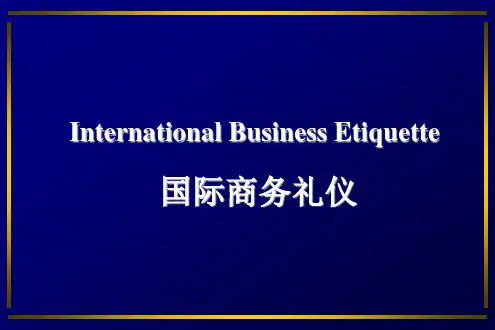
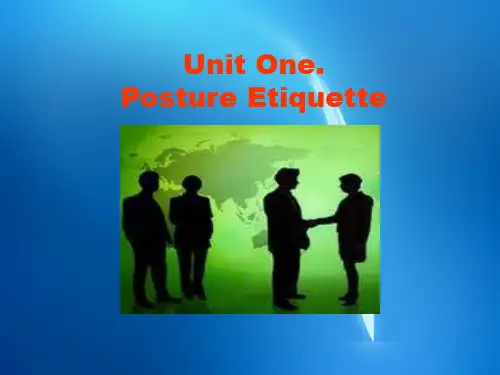

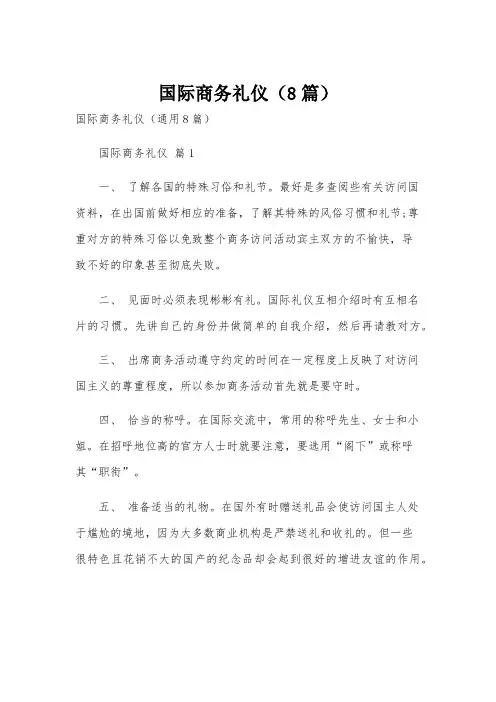
国际商务礼仪(8篇)国际商务礼仪(通用8篇)国际商务礼仪篇1一、了解各国的特殊习俗和礼节。
最好是多查阅些有关访问国资料,在出国前做好相应的准备,了解其特殊的风俗习惯和礼节;尊重对方的特殊习俗以免致整个商务访问活动宾主双方的不愉快,导致不好的印象甚至彻底失败。
二、见面时必须表现彬彬有礼。
国际礼仪互相介绍时有互相名片的习惯。
先讲自己的身份并做简单的自我介绍,然后再请教对方。
三、出席商务活动遵守约定的时间在一定程度上反映了对访问国主义的尊重程度,所以参加商务活动首先就是要守时。
四、恰当的称呼。
在国际交流中,常用的称呼先生、女士和小姐。
在招呼地位高的官方人士时就要注意,要选用“阁下”或称呼其“职衔”。
五、准备适当的礼物。
在国外有时赠送礼品会使访问国主人处于尴尬的境地,因为大多数商业机构是严禁送礼和收礼的。
但一些很特色且花销不大的国产的纪念品却会起到很好的增进友谊的作用。
六、符合场合的着装。
正装(西服)是参加商务活动或宴请所必要的,女士一般也应着礼服或西服,才会让对方觉得你是很重视此次活动的。
七、把握好与对方的交流技巧。
英语是国际交流语言,如果语言上有沟通障碍,可随团带备或在当地聘请一位翻译。
此外开场白都非常简短,大多数的交流也都是很快进入正题;在会议中切忌坐姿保持端正或忌讳二三人悄悄私语,萎靡不振等状态,这些都是对交流双方的不尊重并会引致反感。
国际商务礼仪篇2卓越女性课程上,来自瑞士,拥有30年经验的酒店管理专家AndyMannhart主讲了“国际商务礼仪”课。
一堂课后,学员们纷纷表示“内容多到记不下来”。
原来,如何请客吃饭,如何握手,如何打招呼……这些商务活动都大有讲究!商务宴请应先问客人喜欢哪家餐厅,口味有何偏好。
客人到达之前,主人应先到场,并把最好的座位留给客人。
客人不能独自用餐。
如果对食物不满意,应由主人提出投诉,切记:无论如何不要提高嗓门。
用餐过程当中一般不能离开和打手机。
实在有需要,应在两道菜之间离开。
